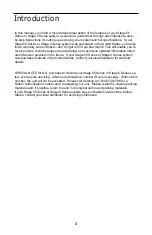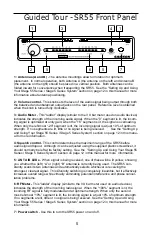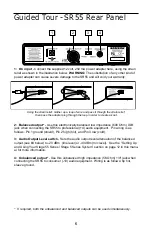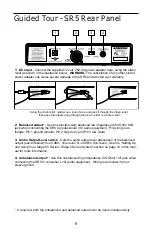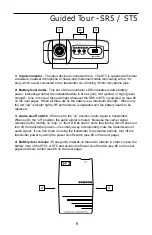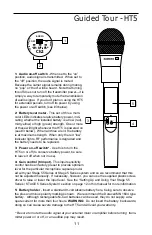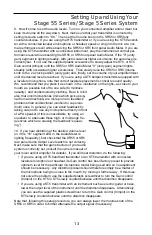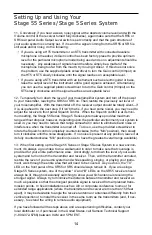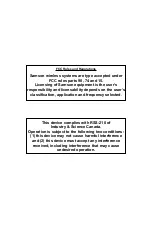
16
Specifications
Transmitter (ST5 and HT5):
Transmission Mode
Frequency modulation, 80KF3E, 15 kHz peak deviation
Frequency Range
173.80 MHz to 213.20 MHz, 25 frequencies
Band A (European / UK models)
160.10 to 177.90 MHz
Band B (European / UK models)
189.10 to 210.10 MHz
OSC System
Crystal controlled, x12 multiplication
RF Power
20 mW (USA models), 2 mW (European / UK models)
Operating Range
300 ft.
Frequency Stability
± 10 ppm
Approvals
Complies with ETS 300 422 and FCC Part 74
Radiating Harmonic and Spurious Emission
Below limits of applicable regulations
Antenna Type
Internal
Audio Frequency Response
40 Hz to 15 kHz ±3 dB
Pre-Emphasis
50 µSec
Noise Reduction System
NE571 based compandor
Signal To Noise Ratio
> 100 dB
Maximum Input Level
0 dBv (ST5), -20 dBv (VH3)
T.H.D.
< 1% @ 1 kHz
Current Consumption
34 mA (typical)
Battery Life (MN1604 9-volt alkaline)
6 hours (typical)
Operating Temperature
-10 to +55 degrees C
Controls
ST5
Power On/Off, Audio On/Off, Attenuation (switch), Level Control (Trimpot)
HT5
Power On/Off, Audio On/Off, Level Control (Trimpot)
LED Indicator
Battery high/medium/low
Dimensions
ST5
65 (W) x 22 (H) x 100 (D) mm (2.6 x .87 x 4 in.)
HT5
37 (W) x 233 (H) mm (1.46 x 9.17 in.)
Weight
ST5
100 grams • 3.55 oz.
HT5
200 grams • 7.1 oz.
Receiver SR55 and SR5:
Receiving System
SR55
Single conversion Superheterodyne, Diversity
SR5
Single conversion Superheterodyne, Non-Diversity
Frequency Range
173.80 MHz to 213.20 MHz, 25 frequencies
Band A (European / UK models)
160.10 to 177.90 MHz
Band B (European / UK models)
189.10 to 210.10 MHz
Receiving Mode
80KF3E
Sensitivity
< 3 µV for 20 dB SINAD, < 10 µV for 50 dB S/N
Selectivity
120 kHz BW, nominal @ -6 dB, ± 300 kHz (adj CH), -75 dB
Squelch Sensitivity
3 µV to 250 µV adjustable
Intermediate Frequency
10.7 MHz
Local Oscillator System
Crystal controlled
Noise Reduction System
NE571 based compandor
De-emphasis
50 µsec.
Signal To Noise Ratio
> 100 dB (IHF-A) line out, > 90 dB (IHF-A), mic out
Audio Frequency Response
40 Hz to 15 kHz ±3 dB
T.H.D.
< 1% @ 1 kHz
Audio Output Levels
-10dB unbalanced (1/4" phone connector),
-20 dBm / -40 dBm balanced (XLR connector)
Audio Output Impedance
5 k
Ω
unbalanced, 600
Ω
balanced
Antennas
1/4 wavelength telescopic
Operating Temperature
-10 to +55 degrees C
Controls
Volume, Squelch, Power
LED Indicators
SR55
Antenna A or B (2 LEDs) /AF Level (6 LEDs) / RF Level (6 LEDs)
SR5
TX On / AF Level (6 LEDs) / RF Level (6 LEDs)
Power Requirement
12 Volts DC, 100 mA typical (110 mA max.), AC adapter supplied
Dimensions (W x H x D, without antennas)
216 x 44 x 116 mm (8.5 x 1.75 x 4.6 in.)
Weight (including antennas)
20 g • 0.75 lb



